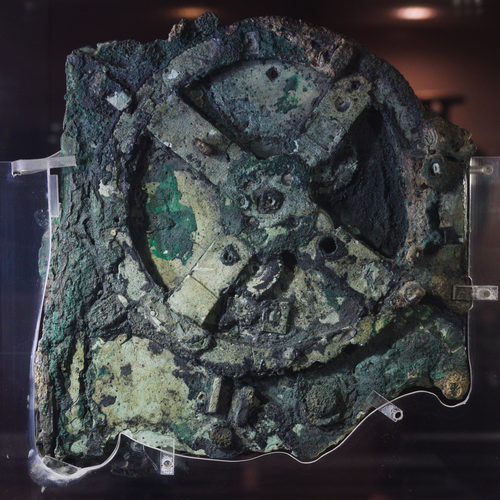
What is the Antikythera mechanism? It is a machine that was found in an ancient shipwreck near the island of Antikythera, a Greek island on the edge of the Aegean Sea. It is thought to be a machine to predict eclipses, model the lunar phases, and track astronomical cycles. It is also said to be the first ever analogue computer.
The Antikythera mechanism was found by a group of sponge divers. They were diving off the island of Antikythera in 1900 when they came across the wreckage of a ship, 45 m down. With help from the Greek Navy, they managed to take a lot of artifacts off the ship. They found statues, pottery, glassware, coins, jewelry, and what looked like a lump of metal parts. Analysis of the things found showed that the ship was most likely a Roman cargo ship, probably from the 1st century BC. Nobody knows where it was going from and to, but there is a high probability that it was transporting valuable goods that had been captured during General Sulla’s sack of Athens in 87 BC. There is no way of proving this, but it would explain why such valuable Greek objects were on a Roman cargo ship.
When they brought the Antikythera mechanism to the surface, they had no idea what it was. It was made of wood and bronze, but it had been under the sea for over two thousand years, and wood and bronze don’t do very well in that kind of environment. The chlorine in the seawater had corroded the bronze and turned it into a material called atacamite. When the mechanism was brought to the surface, this atacamite deformed, changing the dimensions of all of the pieces within it, making it even more difficult to figure out what it was.
It would take scientists almost a century to work out what all of the pieces were and how they go together. A few years after the box had been found, experts found something that looked like a gear in it. They thought it might be some kind of astronomical clock, but if it was, it would predate any such clocks by a long time. After the Second World War, other people tried to work out what the mechanism was, and slowly different gears began to reveal themselves. Using X-ray, they were able to get fine details and even work out how many teeth were on the cogs. Through this, they gradually began to get an idea of what the device was for. It was a system for computing the positions of the planets, phases of the moon, and predicting eclipses. The front and the back of the box had dials and planets that could have been marked with precious stones. When the box was set and wound, all of the cogs would move, giving an idea of where certain planets would be.
This computer was a fiendishly complicated undertaking, but it showed how far advanced Greek astronomy and technology were. They had picked up most of their astronomy from the Babylonians, but they had built on it with centuries of observations. As they had a geocentric view of the solar system, there were a lot of things they were wrong about, such as the motion of Mars, and they even built these ideas into the machine. It was an incredible feat of astronomy and also of mathematics because all of the numbers of teeth needed to be calculated.
Historians were amazed by the level of astronomy, but also by the level of machining that went into making the cogs. Up until the Antikythera was found, it was thought that the Greeks could only make large cogs, not such fine and delicate ones. It has been proposed that the machine would have jammed if it were used too much, but that is a problem that only became fixable with precision milling in the 19th century.
One thing that historians wonder about is who made it and why other such machines haven’t been found. The great orator Cicero talks about such a machine that was made by Archimedes and taken to Rome in 212 BC. Cicero writes about seeing a demonstration of it. Historians think that this machine was probably built in a workshop in Rhodes by a famous astronomer called Hipparchus. A contraption as advanced as the Antikythera mechanism must have been the product of a lot of experimentation, and you would think that there would be evidence of such experimentation. However, they were all made of Bronze, and Bronze is not a cheap metal. If the machines weren’t used or if they didn’t work, they would most likely be melted down. Maybe there are more of them lying at the bottom of the sea, or waiting in a cave somewhere to be found. The fact that it exists shows that the Greeks were capable of making it, but it would take many centuries before something similar could be made again. And this is what I learned today.
Sources
https://en.wikipedia.org/wiki/Antikythera_mechanism
https://en.wikipedia.org/wiki/Atacamite
https://en.wikipedia.org/wiki/Gear
https://www.mdpi.com/2079-6412/13/9/1630
Images By Logg Tandy, CC BY-SA 4.0, https://commons.wikimedia.org/w/index.php?curid=164647291
